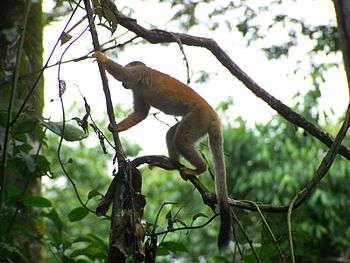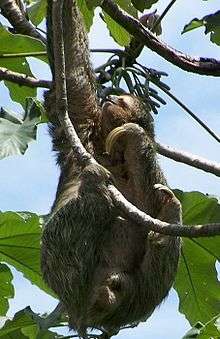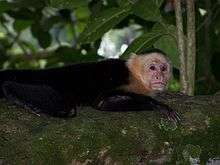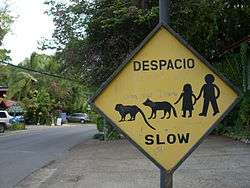Manuel Antonio National Park
Manuel Antonio National Park (Spanish: Parque Nacional Manuel Antonio) is a national park in the Central Pacific region of Costa Rica in the municipality of Manuel Antonio, 7 km south of Quepos.

Understand
The park is one of the most visited parks in Costa Rica as it is easily accessible from San José. Each year the park is visited by more than 150,000 people. With an area of only 16.24 km2 it is the smallest park in Costa Rica. It has an exceptional beauty and in 2011 the American magazine Forbes named it one of the 12 most beautiful parks in the world.
However, others people say the park is overrated, overcrowded and overpriced. The visible bio-diversity is limited due to the many tourist strolling along the trails. Furthermore, the monkeys are so used to getting fed by the tourists that they become aggressive and do attack people with bags and backpacks. If instead you feel US$15 might just be a little too much, you are better off visiting Cahuita National Park instead, which is also more affordable and versatile to the naked eye.
History
The park was created in November 1972, to an extent to protect it from development as the area's tourist industry began to boom.
Landscape
The topography of the coastal area is rugged and has slopes of 20% or more. The altitude varies from 0 to 160 meters above sea level. Off the coast are small islands that are part of the national park. The forest-covered peninsula Punta Catedral was once an island and is connected to the mainland by sedimentation. As a result, a sandy strip has arisen, a phenomena called Tombolo. The beaches, Playa Espadilla Sur and Playa Manuel Antonio, are among the most beautiful in Costa Rica. The beaches Escondido and Playita are outside the borders of the park and can be visited for free.
Flora and fauna
Manuel Antonio National Park is rich in flora and fauna. There are 352 species of birds, 109 species of mammals and 346 species of plants registered. The ocean has a great diversity of marine fauna. In the area often birds like toucans, pelicans, ospreys, kingfishers and cayenne bosral (aramids cajaneus) are observed. Iguanas, lizards and snakes are common. Some of the most prominent mammals present are the raccoon, coati, agouti (rodents), two- and three-toed sloth, and capuchin, squirrel, howler and titi monkeys. During the dry season animals can be observed more easily as they go to the beaches for food.
Climate
The dry season lasts from December through March, but it is commonly rather humid year-round. In rainy season some of the paths can get extremely muddy, on the other hand you have the chance to experience the park rather empty. The rain makes the plants grow in all their green glory.
Climate: Dry Dec-Apr, Wet May-Nov, Wettest Sep/Oct
Temp: Average high 33°C (92°F)
Get in
By plane
Quepos Managua National Airport (XQP IATA) is 8 km from Manuel Antonio. Nature Air and Sansa Airlines offer daily flights from San José and Liberia. Quepos airport is a US$20 cab ride into town/Manuel Antonio Park. You must pay a $3/person airport entry/exit fee when using the Quepos airport (though it does have free wifi). If flying internationally from Quepos (via San José International Airport), you can pay for the departure tax in Quepos though it's US$5 more expensive but saves you from having to line up to pay the departure tax when you're in San José International airport.
By bus
There is a bus driving the route Quepos-Manuel Antonio that leaves every 30 minutes from 07:00-22:00. You can catch the bus at any of the many stops along the way. Fare ₡300 each way (+506 777-03-18).
Fees and permits
The park entrance is about 5 minutes’ walk from the bus terminal. The fee is US$15 per person. It is only US$2 if you can show your residence card. There is a limit of 600 allowed (simultaneous) visitors on weekdays and 800 on weekends, but this tends only to be a problem in the Easter week and the last week of the year. At these times you might have to stand in queue and wait for someone to leave before you are let in if you arrive late.
You can also hire a guide to show you around and point out animals for US$25 per person in larger groups, or US$35 per person in very small groups. They are required to speak English. It is worth the money, as some animals are right in front of you, but you do not see them until they are pointed out to you. The guides carry lenses on tripods and you can see through them and even take pictures using a digital camera, traditional film cameras will not give a close up of the animal.
Near Playa Manual Antonio beach are toilets, showers and changing rooms available. There are picnic tables, but an undisturbed lunch is not guaranteed. There is a high probability that Capuchin monkeys will carefully observe your moves in a noisy way (do not feed the animals!) On the beach, the monkeys are in competition with coatis: these animals are very photogenic but also very adept at stealing from unsuspecting sunbathers.
If you go to the park for a swim, take snorkeling equipment along. Playa Manuel Antonio is a great place for snorkeling as it has silky white sand and a beautiful coral reef.
Get around

Once close to Manuel Antonio, it is possible to walk from most hotels to the beach and to any restaurants or attractions in between. There is a public bus route which will take along the one road to the beach to the hotels and restaurants that service the tourist trade. Bus rides costs ₡315 and may not accept US dollars (will provide change).
There are no street lights, and no side walks to the hotels, so carry a flash light to walk along the road. The park itself closes before dark, but walking between your hotels and restaurants will require a flashlight and in the raining season good quality shoes to avoid stepping in the mud and tripping over the rocks in the unpaved road.
There is a small field, at the entrance to the park, where one can park their car for a high fee, and buy a fruit or soda before one enters the park. None are sold inside the park. Be sure to pack your trash, and take it out with you. The garbage barrels are few and far between and littering in the beautiful place is a mortal sin of a dozen major religions and over 50 minor ones.
The Parque Nacional de Manuel Antonio can be reached quite easily by foot, but at high tide a ferry is (often) required to reach it, costing a nominal fee. The intrepid traveler could, of course, ford the waters by swimming it, but help the local economy and pay for the boat ride. At low tide the rives is 15 cm (6 inches) deep and 1 m (3 feet) wide.
This is a 650 m (1/2 mile) hilly long walk over uneven rocky surface. Shoes, not flip flops, are recommended. If you enter the beach from this entrance, the nicest beach is the first one encounterd. If you have to cross the water the nicest beach will be the last one.
At low tide the river is a meter and half wide (4.5 feet) and 20 cm (8 inches) deep, at high tide it is significantly wider and deeper. You would end up taking the boat. There are two row boats, 3 m and 4.5 m (10 and 14 feet) in length, and there is a small fee. There is another entrance that is a by passing the river, by the northern gate, but it is a significantly longer walk to the beaches. The back entrance is where the tour guides end their tour.
See
The beach. The prettiest beach is the furthest from the park entrance by the cul-de-sac. You enter the park and walk past two beaches in the national park until you make the turn to the left. It is a white sand beach about 650 m (½ mile) in length, in a small crescent. The beach is about 12 m (40 feet) from the jungle to the water. The waves are gentle and the current is not strong. The beach itself is free of trash and litter, as are most beaches in CR. There is no lifeguard.
Outside the National Park there is another beach, which you will pass on the way to the national park, it is free to enter. On this beach, one can rent chairs, surf and boogie boards, and purchase a massage. The waves are significantly larger. There is no lifeguard.
There are no lifeguards at these beaches and one swims at their own risk. There are no marker buoys signaling how far it is safe for one to go. There is not a dangerous current, at Manuel Antonio, but visitors should familiarize themselves with how to swim out of a rip current when going to a new beach that has no lifeguard.
Do

- Hiking in the national park. The trails are well marked and easily accessible. There are four short trails (1-3 km). Trail Perezoso leads to a panoramic view where you have a magnificent view over the bay. There is also a short trail on the peninsula Punta Catedral. You can do the most common one with a guide and then once your tour is over, take time to follow one of the other trails, and also go swim.
- Wildlife watching with guide. US$20 per person.
- Fishing Best place in the world to bend a rod. Huge sailfish and Marlin caught nearly every trip. (http://www.QueposFishAdventure.com Quepos Fish Adventure is a good place to start)
- Relax at the beautiful beaches inside the park. Water is normally clear-blue in color.
- Park tour. With a guide.
Nearly all of the guides have high quality optics. If you have a digital camera it will take a picture through a tripod monted scope. You can get nice and close up. If you have a traditional film camera you should bring a telephoto lens for close up shots of the fast moving animals.
Buy
At Playa Espadilla and at the entrance of the park are souvenir shops. Regalame Art Gallery (part of Hotel Si Como No) has a great selection (expensive) quality souvenirs.
Eat
It is not possible to buy food or drinks inside the park, although just outside the park there are plenty of opportunities to do so. Take care not to allow your lunches to be infiltrated or stolen by the park's resident thieves, the coatimundi. While swimming in the ocean, make sure your backpack does not have food in it. If it does coatimundi will try to open it (and they don't know how zippers work).
There are four large picnic tables by the bathroom. The tables are on a raised concert platform.
Most of the hotels have a full service restaurants. There are other full service restaurants where one can enjoy a dinner under roof with an sun set kissing the ocean. See Manuel Antonio#Eat.
Drink
There is a water faucet at by the picnic tables. The water is supplied by a local well that brings in slightly brackish water. The basin it runs into is very shallow and it is difficult to refill your water bottles. Bring cups.
Sleep
Lodging
Because camping is prohibited within the park, a number of lodging choices have sprung up around the perimeter of the park. One of the popular local lodging offerings consists of "cabinas" (cabins) which vary in price (US$20-30/night) and quality. Cabinas Pedro Miguel (+506 777-00-35) and Cabinas Piscis (tel.777-00-46) and Cabinas Sol y Mar (+506 777-14-68) are a few popular choices for this type of lodging. The Manuel Antonio Park area also has a number of hotels which average about US$50-$60/night. See also Manuel Antonio#Sleep.
- 🌍 El Faro Beach Hotel (Hotel El Faro), Manuel Antonio National Park entrance (At the Manuel Antonio National Park entrance 400 m from the beach.), ☎ +506 2777 5115, e-mail: info@elfaro.cr. Authentic shipping containers have been stylishly transformed into a unique eco-friendly hotel with private balconies and unparalleled views. Starting at US$70 per room plus tax including breakfast.
Camping
Camping is prohibited in the park, as it is small and the impact of even a few people could possibly damage the fragile natural environment that the park is attempting to maintain.
Backcountry
- Quepos: Quepos is best known for its port and fishing. It is located 8 km north of Manuel Antonio and is easily reached by bus. Being a gateway to the national park Manuel Antonio there are many hotels and restaurants. Market on Saturday morning.
Stay safe

- Please do not feed the monkeys. As tempting as it may seem and even if others are doing it, please do not feed the monkeys. The reasons to avoid this are endless and doing so contributes to the endangerment of the animals in and around the park. Sometimes they drag bags into the forest or in the trees to get that fragrant banana and take your camera along with it. Do not feed any of the wild animals for that matter. They are developing a taste for Human food and will steal your lunch. You will be thrown out. The signs warning you of this are in English.
- The road from Quepos to the park goes up and down. There are many blind corners and Costa Rican drivers are no less reckless than elsewhere. The distance from your hotel to the beach is probably larger than you initially expected. Take a bus or a taxi and walk as little as possible on the dangerous road (also to avoid the scorching sun), or select your accommodation near the National Park entrance, especially after sunset or during a tropical rainstorm. If you walk in the dark, for example from a restaurant back to your hotel, take a flashlight along and always walk on the left side of the road.
- If you are going to the park, make sure you have reached the National Park entrance before purchasing anything. Especially outside the peak season there are numerous con artists stopping people on the way to the park to sell them fake tickets, expensive parking and useless guide services. Sometimes they cover traffic signs with posters and use clothes resembling park rangers. Coopealianza Bank located right at the entrance of the park is the only real place allowed to sell the entrance tickets. Make sure you get there before stopping.
- It is not rare that a crocodile finds his way between the bathers.
- On the edge of the beach are manchineel trees (manzanillo), or beach apple. These are recognizable by their glossy green foliage and small apples. The tree, leaves and apples of manchineel all contain a strong poison. When breaking a twig or leaf there is a white milky sap that drips out; when it comes into contact with skin, eyes or mucous membranes, it causes burning blisters. This substance may be so toxic that even when you shelter under a manchineel during a rainstorm, the raindrops can cause this nasty response.
- Manuel Antonio village gets a rough, mainly American party town atmosphere at night; pickpocketing and other petty crimes are common. Everything is a negotiation. Parking, etc. Expect to be ripped off.
Go next
- Tárcoles Crocodile Bridge – If you go by car or shuttle service you should really stop at Puente Río Tarcoles (the bridge over Tarcoles river) about halfway between San José and Manuel Antonio. This is a favorite spot for crocodiles that come here to warm up before hunting at night.
- Carara National Park – Scarlet macaw are a primary tourist draw to Carara.